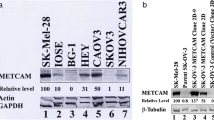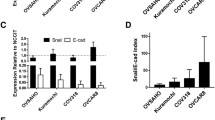Abstract
Objectives: We tested if METCAM/MUC18 overexpression also plays a suppressor role in another human ovarian cancer cell line, BG-1, in addition to the SK-OV3 cell line.
Methods: Human ovarian cancer BG-1 cells were transfected with METCAM/MUC18 cDNA and G418-resistant clones expressing different levels of METCAM/MUC18 were isolated. These clones were used to test the effects of enforced expression of METCAM/MUC18 on in vitro motility, invasiveness, and anchorage-independent colony formation (in vitro tumorigenesis), and in vivo tumorigenesis after SC injection and after IP injection in female athymic nude mice.
Results: Overexpression of METCAM/MUC18 reduced in vitro motility and invasiveness of BG-1 cells and anchorage-independent colony formation (in vitro tumor formation). Higher expression of METCAM/MUC18 in BG-1 cells significantly reduced in vivo tumor proliferation of the BG-1 cells after IP injection (orthotopic route) of the clones in female nude mice, though it did not significantly affect in vivo tumor proliferation after SC injection (non-orthotopic route).
Conclusion: Similar to SK-OV3 cells, METCAM/MUC18 also plays a suppressor role in the progression of BG-1 cells in a xenograft mouse model.
Access this chapter
Tax calculation will be finalised at checkout
Purchases are for personal use only
Similar content being viewed by others
Abbreviations
- CAM:
-
Cell adhesion molecule
- huMETCAM/MUC18:
-
Human METCAM/MUC18
- IHC:
-
Immunohistochemistry
- IP :
-
Intraperitoneal
- METCAM:
-
Metastasis-regulating cell adhesion molecule
- SC :
-
Subcutaneous
References
Siegel, R., Ma, J., Zou, Z., & Jemal, A. (2014). Cancer statistics 2014. CA: A Cancer Journal for Clinicians, 64(1), 9–29.
Clarke-Pearson, D. L. (2009). Screening for ovarian cancer. New England Journal of Medicine, 361, 170–177.
Zhao, J., Guo, N., Zhang, L., & Wang, L. (2018). Serum CA125 in combination with ferritin improves diagnostic accuracy for epithelial ovarian cancers. British Journal of Biomedical Science, 75(2), 66–70. https://doi.org/10.1080/09674845.2017.1394051.
McCluggage, W. G., & Wilkinson, N. (2005). Metastatic neoplasms involving the ovary: A review with an emphasis on morphological and immunohistochemical features. Histopathology, 47, 231–247.
Wei, W., Dizon, D., Vathipadiekal, V., & Birrer, M. J. (2013). Ovarian cancer: Genomic analysis. Annals Oncology, 24(Suppl 10), x7–x15.
Menon, U., Griffin, M., & Gentry-Maharaj, A. (2014). Ovarian cancer screening-current status, future directions. Gynecologic Oncology, 132, 490–495.
Jacob, F., Nixdorf, S., Hacker, N. F., & Heinzelmann-Schwarz, V. A. (2014). Reliable in vitro studies require appropriate ovarian cancer cell lines. Journal of Ovarian Research, 7, 60.
Harahan, D., & Weinberg, R. A. (2011). Hallmarks of cancer: The next generation. Cell, 144, 646–674.
Wu, G. J., & Dickerson, E. B. (2014). Frequent and increased expression of human METCAM/MUC18 in cancer tissues and metastatic lesions associates with the clinical progression of human ovarian carcinoma. Taiwanese Journal of Obstetrics and Gynecology, 53, 509–517.
Wu, G. J. (2017). METCAM/MUC18 plays a novel tumor and metastasis suppressor role in the progression of human ovarian cancer cells. Obstetrics & Gynecology International Journal, 6(4), 00210.
Wu, G. J., Wu, M. W. H., Wang, S. W., Liu, Z., Peng, Q., Qu, P., Yang, H., Varma, V. A., Sun, Q., Petros, J. A., Lim, S., & Amin, M. B. (2001). Isolation and characterization of the major form of human MUC18 cDNA gene and correlation of MUC18 overexpression in prostate cancer cells and tissues with malignant progression. Gene, 279, 17–31.
Wu, G. J. (2005). METCAM/MUC18 expression and cancer metastasis. Current Genomics, 6, 333–349.
Lehmann, J. M., Reithmuller, G., & Johnson, J. P. (1989). MUC18, a marker of tumor progression in human melanoma. Proceedings of National Academy of Sciences of the United States of America, 86, 9891–9895.
Wu, G. J. (2018). Chapter 13: Dual role of METCAM/MUC18 in the progression of human cancer cells. In F. Uchiumi (Ed.), Gene expression and regulation in mammalian cells (pp. 257–289). Rijeka, Croatia. ISBN 978-953-51-3856-3, Print ISBN 978-953-51-3855-6: InTech-Open Access Publisher.
Wu, G. J., & Zeng, G. F. (2016). METCAM/MUC18 is a novel tumor and metastasis suppressor for the human ovarian cancer SKOV3 cells. BMC Cancer, 16, 136. https://doi.org/10.1186/S12885-016-2181-9.
Geisinger, K. R., Kute, T. E., Pettenati, M. J., Welander, C. E., Dennard, Y., Collins, L. A., et al. (1989). Characterization of a human ovarian carcinoma cell line, BG-1, with estrogen and progesterone receptors. Cancer, 63, 280–288.
Buick, R. N., Pullano, R., & Trent, J. M. (1985). Comparative properties of five human ovarian adenocarcinoma cell lines. Cancer Research, 45, 3668–3676.
Wu, G. J., Qiong, P., Fu, P., Wang, S.-W., Chiang, C. F., Dillehay, D. L., & Wu, M. W. H. (2004). Ectopical expression of human MUC18 increases metastasis of human prostate cancer cells. Gene, 327, 201–213.
Wu, G. J., Wu, M. W. H., & Liu, Y. (2011). Enforced expression of human METCAM/MUC18 increases the tumorigenesis of human prostate cancer cells in nude mice. Journal of Urology, 185, 1504–1512.
Passaniti, A., Isaacs, J. T., Haney, J. A., Adler, S. W., Cujdik, T. J., Long, P. V., & Kleinman, H. K. (1992). Stimulation of human prostatic carcinoma tumor growth in athymic mice and control of migration in culture by extracellular matrix. International Journal of Cancer, 51, 318–324.
Leone, A., Flatow, U., King, C. R., Sandeen, M. A., Margulies, I. M., Liotta, L. A., & Steeg, P. S. (1991). Reduced tumor incidence, metastatic potential and cytokine responsiveness of nm-23 transfected melanoma cells. Cell, 65, 25–35.
Zeng, G., Cai, S., & Wu, G. J. (2011). Up-regulation of METCAM/MUC18 promotes motility, invasiveness and tumorigenesis of human breast cancer cells. BMC Cancer, 11, 113. https://doi.org/10.1186/1471-2407-11-113.
Zeng, G., Cai, S., Liu, Y., & Wu, G. J. (2012). METCAM/MUC18 augments promotes migration, invasion and tumorigenicity of human breast cancer SK-BR-3 cells. Gene, 492, 229–238.
Pretlow, T. G., Delmoror, A. M., Dilley, G. G., Spadafora, E. G., & Pretlow, T. P. (1991). Transplantation of human prostatic carcinoma into nude mice in Matrigel. Cancer Research, 51, 3814–3817.
Shaw, T. J., Senterman, M. K., Dawson, K., Crane, C. A., & Vanderhyden, B. C. (2004). Characterization of intraperitoneal, orthotopic, and metastatic xenograft models of human ovarian cancer. Molecular Therapy, 10, 1032–1042.
Yi, X. F., Yuan, S. T., Lu, L. J., Ding, J., & Feng, Y. J. (2005). A clinically relevant orthotopic implantation nude mouse model of human epithelial ovarian cancer—Based on consecutive observation. International Journal of Gynecological Cancer, 15, 850–855.
Aldovini, D., Demichelis, F., Doglioni, C., Di Vizio, D., Galligioni, E., Brugnara, S., et al. (2006). M-CAM expression as marker of poor prognosis in epithelial ovarian cancer. International Journal of Cancer, 119(8), 1920–1926.
Wu, Z., Wu, Z. Y., Li, J., Yang, X., Wang, Y., Yu, Y., et al. (2012). MCAM is a novel metastasis marker and regulates spreading, apoptosis and invasion of ovarian cancer cells. Tumor Biology, 33, 1619–1628.
Wu, G. J. (2016). Ectopic expression of MCAM/MUC18 increases in vitro motility and invasiveness, but decreases in vivo tumorigenesis and metastasis of a mouse melanoma K1735-9 subline in a syngeneic mouse model. Clinical & Experimental Metastasis, 33(8), 817–828. https://doi.org/10.1007/s10585-016-9812-z.
Lin, J. C., Chiang, C. F., Wang, S. W., Wang, W. Y., Kwan, P. C., & Wu, G. J. (2014). Significance and expression of human METCAM/MUC18 in nasopharyngeal carcinoma (NPC) and metastatic lesions. Asian Pacific Journal of Cancer Prevention, 15(1), 245–252.
Liu, Y. C. (2014). The putative role of human METCAM/MUC18 in modulating the development and progression of nasopharyngeal carcinoma. M.S. thesis under the supervision of Dr. Guang-Jer Wu, Department of Bioscience Technology, Chung Yuan Christian University, Chung Li, Taiwan. http://www.lib.cycu.edu.tw/thesis.
Li, Q., Yu, Y., Bischoff, J., Milliken, J. B., & Olsen, B. R. (2003). Differential expression of CD146 in tissues and endothelial cells derived from infantile haemangioma and normal human skin. The Journal of Pathology, 201, 296–302.
Wu, G. J., Fu, P., Wang, S.-W., & Wu, M. W. H. (2008). Enforced expression of MCAM/MUC18 increased in vitro motility and invasiveness and in vivo metastasis of two mouse melanoma K1735 Sublines in a syngeneic mouse model. Molecular Cancer Research, 6(11), 1666–1677.
Zeng, Q., Li, W., Lu, D., Wu, Z., Duan, H., Luo, Y., et al. (2012). CD146, an epithelial-mesenchymal transition inducer, is associated with triple-negative breast cancer. Proceedings of the National Academy of Sciences of the United States of America, 109(4), 1127–1132.
Wu, G. J. (2012). Dual roles of METCAM in the progression of different cancers. Journal of Oncology, 2012, 853797. https://doi.org/10.1155/2012/853797.
Vecchiarelli-Federico, L. M., Cervi, D., Haeri, M., Li, Y., Nagy, A., & Ben-David, Y. (2010). Vascular endothelial growth factor—A positive and negative regulator of tumor growth. Cancer Research, 70, 863–867.
Adhikary, S., & Eilers, M. (2005). Transcriptional regulation and transformation by Myc protein. Nature Review. Molecular Cell Biology, 6, 635–645.
Aguirre-Chiso, J. A. (2007). Models, mechanisms and clinical evidence for cancer dormancy. Nature Review. Cancer, 7, 834–846.
Acknowledgments
I thank Eugene Lee Son, Jonathan Geekai Chang, and Guofang Zeng for technical supports. This project was supported by the research funding of Emory University School of Medicine, Atlanta, GA, USA and funds of National Science Council, Taiwan.
Author information
Authors and Affiliations
Corresponding author
Editor information
Editors and Affiliations
Ethics declarations
The author declares no conflicts of interest.
Rights and permissions
Copyright information
© 2021 Springer Nature Switzerland AG
About this chapter
Cite this chapter
Wu, GJ. (2021). Enforced Expression of METCAM/MUC18 Decreases In Vitro Motility and Invasiveness and Tumorigenesis and In Vivo Tumorigenesis of Human Ovarian Cancer BG-1 Cells. In: Schatten, H. (eds) Ovarian Cancer: Molecular & Diagnostic Imaging and Treatment Strategies. Advances in Experimental Medicine and Biology, vol 1330. Springer, Cham. https://doi.org/10.1007/978-3-030-73359-9_8
Download citation
DOI: https://doi.org/10.1007/978-3-030-73359-9_8
Published:
Publisher Name: Springer, Cham
Print ISBN: 978-3-030-73358-2
Online ISBN: 978-3-030-73359-9
eBook Packages: Biomedical and Life SciencesBiomedical and Life Sciences (R0)




